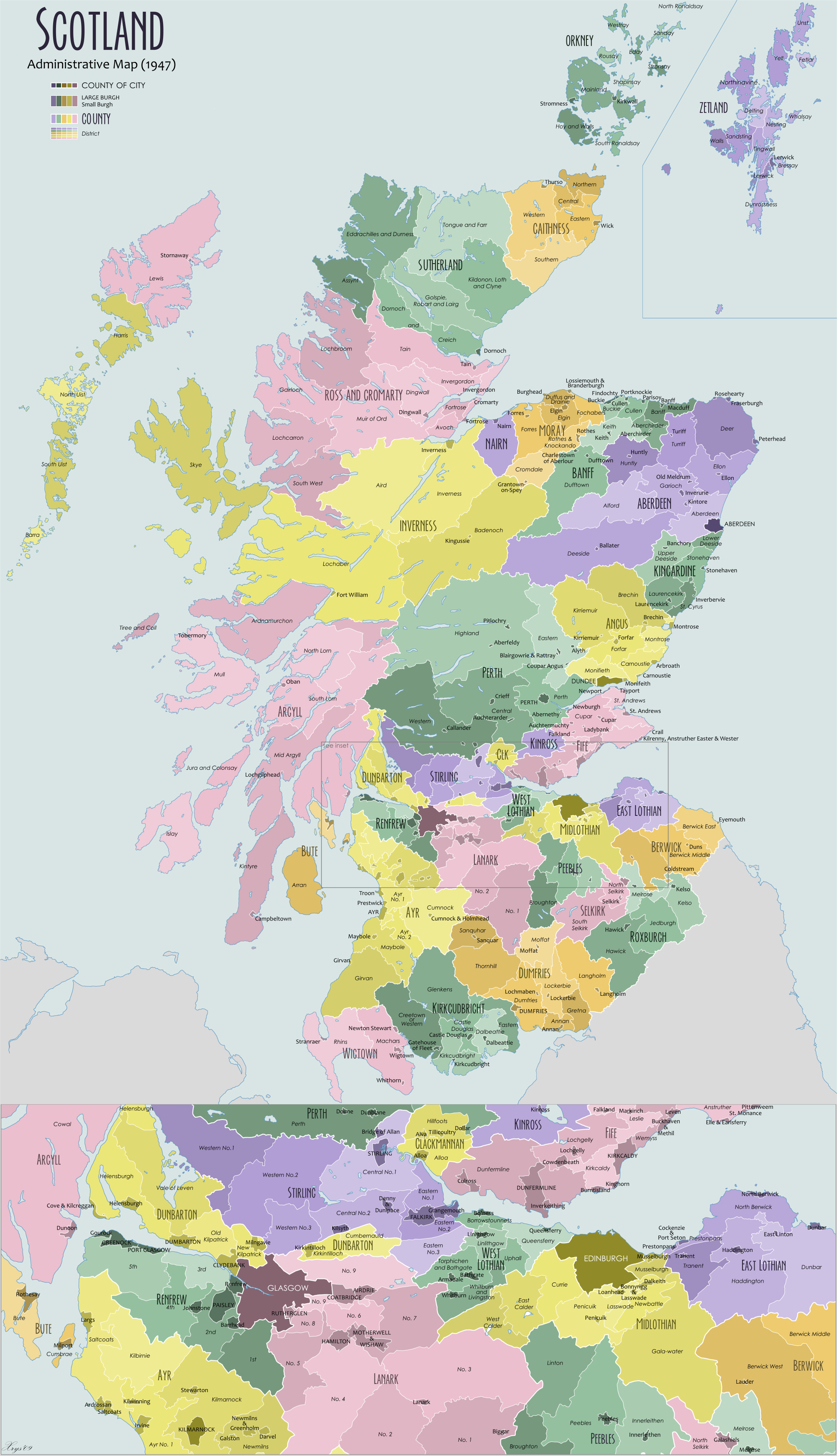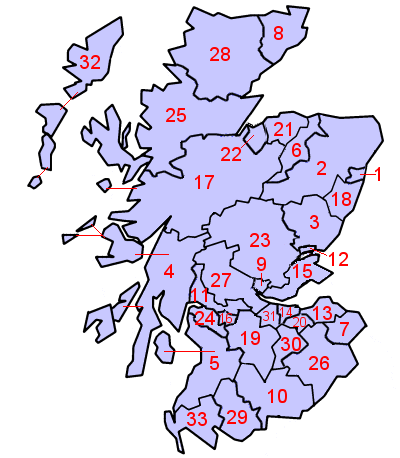|
Dunbartonshire
Dunbartonshire () or the County of Dumbarton is a Shires of Scotland, historic county, lieutenancy areas of Scotland, lieutenancy area and registration county in the west central Lowlands of Scotland lying to the north of the River Clyde. Dunbartonshire borders Perthshire to the north, Stirlingshire to the east, Lanarkshire and Renfrewshire to the south, and Argyllshire to the west. The county covered a similar area to the earldom and later duchy of Lennox (district), Lennox. The historic county gives its name to two of Scotland's modern council areas, being East Dunbartonshire and West Dunbartonshire. Name The town name "Dumbarton" comes from the Scottish Gaelic meaning "fort of the Britons (historical), Britons". Historically, the spelling of the county town and the county were not standardised. By the 18th century the names "County of Dunbarton" and "County of Dumbarton" were used interchangeably. The n in "Dunbarton" represents the etymology "fort"; the "m" in "Dumbarton" ... [...More Info...] [...Related Items...] OR: [Wikipedia] [Google] [Baidu] |
West Dunbartonshire
West Dunbartonshire (; , ) is one of the 32 Local government in Scotland, local government council areas of Scotland. The area lies to the north-west of the Glasgow City council area and contains many of Glasgow's commuter towns and villages. West Dunbartonshire also borders Argyll and Bute, East Dunbartonshire, Renfrewshire and Stirling (council area), Stirling. The council area was formed in 1996 from the former Clydebank (district), Clydebank district and the eastern part of Dumbarton (district), Dumbarton district, which had both been part of Strathclyde Regions and districts of Scotland#Regions, Region. West Dunbartonshire has three main urban areas: Clydebank, Dumbarton and the Vale of Leven. The area also includes the intervening rural areas, including the Kilpatrick Hills and the south-eastern bank of Loch Lomond. The council is based at Dumbarton Burgh Hall, 16 Church Street in Dumbarton, although Clydebank is the largest town. History West Dunbartonshire was created ... [...More Info...] [...Related Items...] OR: [Wikipedia] [Google] [Baidu] |
East Dunbartonshire
East Dunbartonshire (; , ) is one of the 32 council areas of Scotland. It borders Glasgow City Council Area to the south, North Lanarkshire to the east, Stirling (council area), Stirling to the north, and West Dunbartonshire to the west. East Dunbartonshire contains many of the suburbs in the north of Greater Glasgow, including Bearsden, Milngavie, Bishopbriggs, Kirkintilloch, Lenzie, Twechar, Milton of Campsie, Balmore, and Torrance, East Dunbartonshire, Torrance, as well as some other of Glasgow's commuter towns and villages. The council area covers parts of the Historic counties of Scotland, historic counties of Dunbartonshire, Lanarkshire, and Stirlingshire. The council area was formed in 1996, as a result of the Local Government etc. (Scotland) Act 1994, from the former Bearsden and Milngavie districts and most of the former Strathkelvin Local government areas of Scotland 1973 to 1996, district, which had been part of the Strathclyde region. History East Dunbartonshire wa ... [...More Info...] [...Related Items...] OR: [Wikipedia] [Google] [Baidu] |
Dumbarton
Dumbarton (; , or ; or , meaning 'fort of the Britons (historical), Britons') is a town in West Dunbartonshire, Scotland, on the north bank of the River Clyde where the River Leven, Dunbartonshire, River Leven flows into the Clyde estuary. In 2006, it had an estimated population of 19,990. Dumbarton was the capital of the ancient Kingdom of Strathclyde, and later the county town of Dunbartonshire. Dumbarton Castle, on top of Dumbarton Rock, dominates the area. Dumbarton was a royal burgh between 1222 and 1975. Dumbarton emerged from the 19th century as a centre for shipbuilding, glassmaking, and whisky production. However, these industries have since declined, and Dumbarton today is increasingly a commuter town for Glasgow east-southeast of it. Dumbarton F.C. is the local football club. Dumbarton is home to BBC Scotland's drama studio. History Dumbarton history goes back at least as far as the Iron Age and probably much earlier. It has been suggested that in Ancient Rom ... [...More Info...] [...Related Items...] OR: [Wikipedia] [Google] [Baidu] |
Loch Lomond
Loch Lomond (; ) is a freshwater Scottish loch which crosses the Highland Boundary Fault (HBF), often considered the boundary between the lowlands of Central Scotland and the Highlands.Tom Weir. ''The Scottish Lochs''. pp. 33-43. Published by Constable and Company, 1980. Traditionally forming part of the boundary between the shires of Scotland, counties of Stirlingshire and Dunbartonshire, Loch Lomond is split between the Subdivisions of Scotland, council areas of Stirling (council area), Stirling, Argyll and Bute and West Dunbartonshire. Its southern shores are about northwest of the centre of Glasgow, Scotland's largest city. The Loch forms part of the Loch Lomond and The Trossachs National Park which was established in 2002. From a limnological perspective, Loch Lomond is classified as a dimictic lake, meaning it typically undergoes two mixing periods each year. This occurs in the spring and autumn when the water column becomes uniformly mixed due to temperature-driven dens ... [...More Info...] [...Related Items...] OR: [Wikipedia] [Google] [Baidu] |
Stirlingshire
Stirlingshire or the County of Stirling ( ) is a Shires of Scotland, historic county and registration county of Scotland. Its county town is Stirling.Registers of Scotland. Publications, leaflets, Land Register Counties. It borders Perthshire to the north, Clackmannanshire to the east, West Lothian to the south-east, Lanarkshire to the south, and Dunbartonshire to the south and south-west (this latter boundary is split in two owing to Dunbartonshire's Cumbernauld exclave). History In 1130, Stirling, one of the principal royal strongholds of the Kingdom of Scotland, was created a royal burgh by David I of Scotland, King David I. On 11 September 1297, the forces of Andrew Moray and William Wallace defeated the combined English forces of John de Warenne, 6th Earl of Surrey, and Hugh de Cressingham near Stirling, on the River Forth, at the Battle of Stirling Bridge during the First War of Scottish Independence. On 22 July 1298 the Battle of Falkirk saw the defeat of William Wal ... [...More Info...] [...Related Items...] OR: [Wikipedia] [Google] [Baidu] |
The Lennox
The Lennox (, ) is a region of Scotland centred on The Vale of Leven, including its great loch: Loch Lomond. The Gaelic name of the river is ''Lìomhann'', meaning ''the smooth stream'', which anglicises to ''Leven'' (as Gaelic ''mh'' is spirantised). The surrounding area is ''the field of the smooth stream'' - ''Leamhnachd'' in Gaelic; this was originally anglicised as ''Levenauchen'' / ''Levenachs'', then softened into Levenax / Lennax, and eventually the area was known simply as ''Lennox''. Lennox was not one of the so-called seven ancient Provinces of Scotland, but formed as a province in the Middle Ages. The district embraced the whole of the ancient sheriffdom of Dumbarton: the parishes of Rosneath, Arrochar, Row, Luss, Cardross, Bonhill, Dumbarton, Kilmaronock, New Kilpatrick, Old Kilpatrick, Baldernock, Buchanan, Drymen, Killearn, Balfron, Fintry, and Strathblane, with Campsie and Kilsyth, being all within the bounds ruled over by the Earls of Lennox.The ... [...More Info...] [...Related Items...] OR: [Wikipedia] [Google] [Baidu] |
Shires Of Scotland
The counties or shires of Scotland () were historic subdivisions of Scotland. The shires were originally established in the Middle Ages for judicial purposes, being territories over which a Sheriff principal, sheriff had jurisdiction. They were distinct from the various older mormaerdoms, earldoms and other territories into which Scotland was also divided, which are collectively termed the provinces of Scotland by modern historians. The provinces gradually lost their functions, whereas the shires gradually gained functions. From the 16th century, the shires served as county constituency, constituencies, electing shire commissioners to the Parliament of Scotland. From 1667 each shire had Commissioners of Supply, commissioners of supply responsible for collecting local taxes; the commissioners of supply were subsequently given various local government functions as well. From 1797, the shires also served as areas for organising the militia, which was the responsibility of a lord-li ... [...More Info...] [...Related Items...] OR: [Wikipedia] [Google] [Baidu] |
Lennox (district)
The Lennox (, ) is a region of Scotland centred on The Vale of Leven, including its great loch: Loch Lomond. The Gaelic name of the river is ''Lìomhann'', meaning ''the smooth stream'', which anglicises to ''Leven'' (as Gaelic ''mh'' is spirantised). The surrounding area is ''the field of the smooth stream'' - ''Leamhnachd'' in Gaelic; this was originally anglicised as ''Levenauchen'' / ''Levenachs'', then softened into Levenax / Lennax, and eventually the area was known simply as ''Lennox''. Lennox was not one of the so-called seven ancient Provinces of Scotland, but formed as a province in the Middle Ages. The district embraced the whole of the ancient sheriffdom of Dumbarton: the parishes of Rosneath, Arrochar, Row, Luss, Cardross, Bonhill, Dumbarton, Kilmaronock, New Kilpatrick, Old Kilpatrick, Baldernock, Buchanan, Drymen, Killearn, Balfron, Fintry, and Strathblane, with Campsie and Kilsyth, being all within the bounds ruled over by the Earls of Len ... [...More Info...] [...Related Items...] OR: [Wikipedia] [Google] [Baidu] |
Lieutenancy Areas Of Scotland
The lieutenancy areas of Scotland are the areas used for the ceremonial lord-lieutenants, the British monarch, monarch's representatives, in Scotland. The lord-lieutenants' titles chosen by the British monarch, monarch and his legal advisers are mainly based on placenames of the traditional counties of Scotland. In 1794, permanent lieutenancies were established by Warrant (law), Royal Warrant. By the Militia Act 1797 (37 Geo.3, C.103), the lieutenants appointed "for the Counties, Stewartries, Cities, and Places" were given powers to raise and command County Militia Units. While in their lieutenancies, lord lieutenants are among the few individuals in Scotland officially permitted to fly Royal Banner of Scotland, a banner of the Royal Arms of Scotland, the "Lion Rampant" as it is more commonly known. Lieutenancy areas are different from the current local government of Scotland, local government council areas and their committee areas. They also differ from other subdivisions of Sc ... [...More Info...] [...Related Items...] OR: [Wikipedia] [Google] [Baidu] |
Argyllshire
Argyll (; archaically Argyle; , ), sometimes called Argyllshire, is a historic county and registration county of western Scotland. The county ceased to be used for local government purposes in 1975 and most of the area now forms part of the larger Argyll and Bute council area. Argyll is of ancient origin, and broadly corresponds to the ancient kingdom of less the parts which were in Ireland. Argyll was also a medieval bishopric with its cathedral at Lismore. In medieval times the area was divided into a number of provincial lordships. One of these, covering only the central part of the later county, was called Argyll. It was initially an earldom, elevated to become a dukedom in 1701 with the creation of the Duke of Argyll. Other lordships in the area included Cowal, Kintyre, Knapdale, and Lorn. From at least the 14th century there was a Sheriff of Argyll, whose jurisdiction was gradually extended; from 1633 the shire covered all these five provinces. Shires gradual ... [...More Info...] [...Related Items...] OR: [Wikipedia] [Google] [Baidu] |
Local Government (Scotland) Act 1889
The Local Government (Scotland) Act 1889 ( 52 & 53 Vict. c. 50) is an act of the Parliament of the United Kingdom which was passed on 26 August 1889. The main effect of the act was to establish elected county councils in Scotland. In this it followed the pattern introduced in England and Wales by the Local Government Act 1888 ( 51 & 52 Vict. c. 41). County councils The act provided that a county council should be established in each county, consisting of elected councillors. The term "county" was defined as excluding any royal burgh or parliamentary burgh, but with provisions that the county council would have powers over such burghs which met certain criteria, principally being those burghs which had fewer than 7,000 people at the time of the 1881 census. The burghs which remained independent of county council control were not listed in the act, but it was subsequently determined that there were 26 such burghs: *Aberdeen * Airdrie *Arbroath * Ayr *Brechin *Dumbarton *Dumfries ... [...More Info...] [...Related Items...] OR: [Wikipedia] [Google] [Baidu] |





